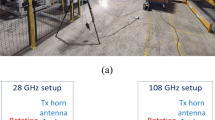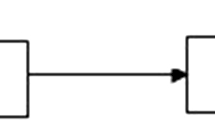Abstract
The ever decreasing geometrical dimensions of electronic devices makes miscellaneous cables or connectors of relatively large dimensions unwanted. Thus, wireless inter/intra-device communications in the millimeter-wave range become a topic of recent interest. In this paper, the excess losses of three groups of typical semi-closed obstacles (connectors, heatsinks, and printed circuit boards) in inter/intra-device communications are measured and empirically modeled. Specific coefficients for each of the obstacles are estimated to describe the excess loss in the millimeter-wave band. Validation shows that the empirical model structure combined with the specific coefficients can provide an effective and simple way to include various semi-closed obstacles in the network planning, simulation, and design of inter/intra-device communications.










Similar content being viewed by others
References
S. Cherry, Edholm’s law of bandwidth, IEEE Spectrum, vol. 41, no. 7, pp. 58–60 (2004).
D. W. Matolak, A. Kodi, and S. Kaya, Channel modeling for wireless networks-on-chips, IEEE Communications Magazine, vol. 51, no. 6, pp. 180–186, (2013).
D. W. Matolak, A. Kodi, S. Kaya, D. DiTomaso, S. Laha, and W. Rayess, Wireless networks-on-chips: architecture, wireless channel, and devices, IEEE Wireless Communications Magazine, vol. 19, no. 5, pp. 58–65, (2012).
IEEE, IEEE Std 802.15.3c-2009 (Amendment to IEEE Std 802.15.3-2003) (2009).
T. Kürner and S. Priebe. Towards THz communications—status in research, standardization and regulation, Journal of Infrared, Millimeter, and Terahertz Waves, vol. 35, no. 1, pp. 53–62, (2014).
S. Redfield, Understanding the ultra-wideband channel within a computer chassis, m.s. thesis, Oregon State University, (2010).
A. Maltsev, R. Maslermikov, A. Sevastyanov, A. Lomayev, A. Khoryaev, A. Davydov, and V. Ssorin, Characteristics of indoor millimeter-wave channel at 60 GHz in application to perspective WLAN system, in Proceedings 4th European Conference Antennas Propagation (EuCAP), Barcelona, Spain, pp. 1–5, (2010).
S. Priebe, C. Jastrow, M. Jacob, T. Kleine-Ostmann, T. Schrader, and T. Kürner, Channel and propagation measurements at 300 GHz, IEEE Transactions Antennas Propagation, vol. 59, no. 5, pp. 1688–1698, (2011).
J. Kunisch and J. Pamp. Ultra-wideband double vertical knife-edge model for obstruction of a ray by a person, in Proceedings IEEE International Conference Ultra-Wideband (ICUWB), vol. 2, pp. 17–20, (2008).
M. Jacob, S. Priebe, A. Maltsev, A. Lomayev, V. Erceg, and T. Kürner, A ray tracing based stochastic human blockage model for the IEEE 802.11ad 60 GHz channel model, in Proceedings 5th European Conference Antennas Propagation (EuCAP), Rome, Italy, pp. 3084–3088, (2011).
M. Jacob, S. Priebe, M. Peter, and M. Wisotzki, Fundamental Analyses of 60 GHz Human Blockage, in Proceedings 7th European Conference Antennas Propagation (EuCAP), Gothenburg, Sweden, pp. 1–5, (2013).
M. Jacob, S. Priebe, R. Dickhoff, T. Kleine-Ostmann, T. Schrader, and T. Kürner, Diffraction in mm and sub-mm Wave indoor propagation channels, IEEE Transactions on Microwave Theory and Techniques, vol. 60, no. 3, pp. 833–844, (2012).
T. Kürner, A. Fricke, S. Rey, P.L. Bars, A. Mounir, and T. Kleine-Ostmann, Measurements and Modeling of Basic Propagation Characteristics for Intra-Device Communications at 60 GHz and 300 GHz, Journal of Infrared, Millimeter, and Terahertz Waves, vol. 36, no. 2, pp. 144–158, (2015).
Rappaport, Theodore S. Wireless Communications Principles and Practice Second Edition, Prentice-Hall, Inc. 19th Printing, pp. 108, (2010).
K. Guan, Z. Zhong, B. Ai, and T. Kürner, Propagation measurements and modeling of crossing bridges on high-speed railway at930 MHz, IEEE Transactions Vehicles Technology, vol. 63, no. 2, pp. 502–517, (2014).
K. Guan, Z. Zhong, B. Ai, and T. Kürner, Empirical models for extra propagation loss of train stations on high-speed railway, IEEE Transactions Antenna Propagation, vol. 62, no. 3, pp. 1395–1408, (2014).
A.G. Longley and P.L. Rice, Prediction of Tropospheric Radio Transmission Loss over Irregular Terrain—A Computer Method, (1968).
J. Epstein and D.W. Peterson, An experimental study of wave propagation at 850 M, in Proceedings IRE, vol. 41, no. 5, pp. 595–611, (1953).
J. Deygout, Multiple knife-edge diffraction of microwaves, IEEE Transactions Antenna Propagation, vol. AP-14, pp. 480–489, (1966).
W.C.Y. Lee, Mobile communications engineering, McGraw Hill Pulications, New York, (1985).
K.L. Chee and T. Kürner, Effect of terrain irregularities and clutter distribution on wave propagation at 3.5 GHz in suburban area, in Proceedings EuCAP, Barcelona, pp. 1–5, (2010).
K. Guan, Z. Zhong, B. Ai, R. He, B. Chen, Y. Li, and C. Briso, Complete propagation modeling in tunnels, IEEE Antennas and Wireless Propagation Letters, vol. 12, pp. 741–744, (2013).
CST MICROWAVE STUDIO [Online]. Available: https://www.cst.com/Products/ CSTMWS.
ANSYS HFSS [Online]. Available: http://www.ansys.com/Products/Simulation+ Technology/Electronics/Signal+Integrity/ANSYS+HFSS.
Acknowledgments
The authors would like to thank Prof. Jörg Schöbel from the Institut für Hochfrequenztechnik at Technische Universität Braunschweig, Germany for providing the W-Band measurement equipment and complementary accessories.
Author information
Authors and Affiliations
Corresponding author
Additional information
This work is supported by the NNSF of China under Grant U1334202 and 61501021, the ZTE corporation, 863 project under Grant 2014AA01A706, and State Key Lab of Rail Traffic Control and Safety Project under Grant RCS2015ZZ001.
Rights and permissions
About this article
Cite this article
Guan, K., Ai, B., Fricke, A. et al. Excess Propagation Loss of Semi-Closed Obstacles for Inter/Intra-Device Communications in the Millimeter-Wave Range. J Infrared Milli Terahz Waves 37, 676–690 (2016). https://doi.org/10.1007/s10762-016-0251-3
Received:
Accepted:
Published:
Issue Date:
DOI: https://doi.org/10.1007/s10762-016-0251-3




